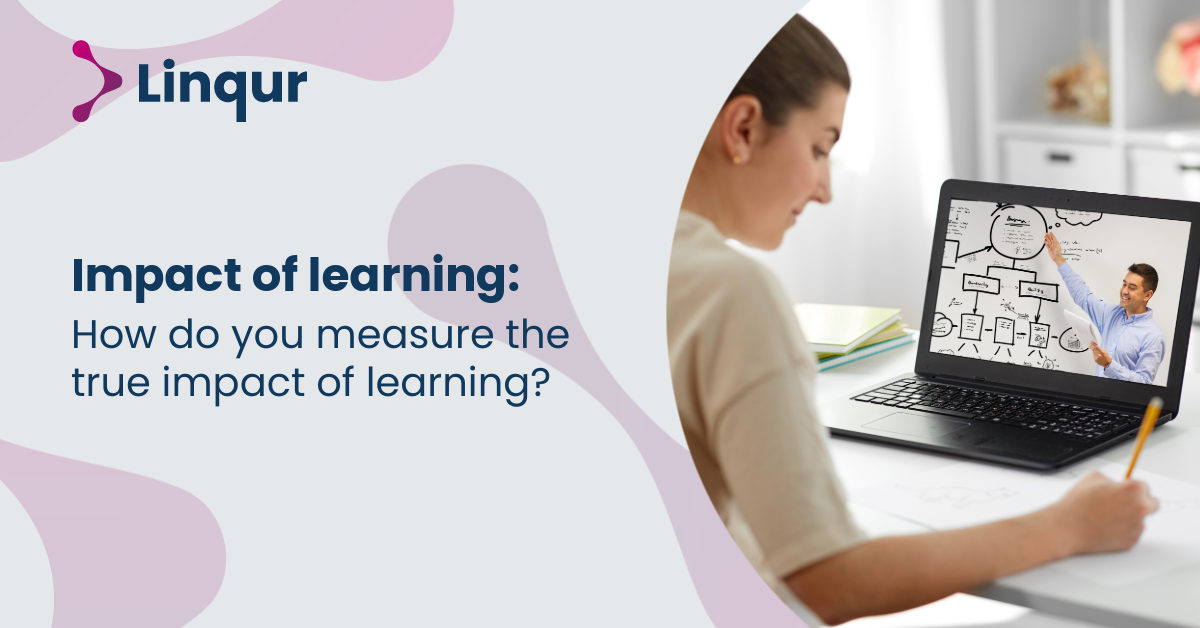Organizations are investing heavily in e-learning. And rightly so, because well-designed online training can yield great results. But developing an e-learning course can quickly cost thousands of euros, time and money that aren’t spent lightly. So, you want to be sure it delivers real value.
After all, learning is never the end goal. You create an e-learning course because you want to change behavior, increase knowledge, or improve performance. But how can you be sure that’s actually happening?
In other words: how do you measure whether your e-learning is effective? And where do you start if you want to make that visible?

The impact of e-learning can be measured on different levels. These range from easy-to-measure responses to highly valuable but harder-to-measure outcomes like behavior and ROI:
1. Reaction
How do participants respond during or immediately after the training? Do they complete the course, and how much time do they spend on it? This is easily measured with a test group or evaluation questions. For example, have participants think out loud or provide feedback through a short survey.
2. Learning
Did participants actually learn something? This can be measured using quizzes or assessments. Many trainings require a minimum passing score, helping you see if the core content was retained.
3. Behavior
Is the learning applied in the workplace? Are employees making fewer mistakes, or handling customers or systems differently? This behavior change can often be observed by managers during day-to-day work or performance reviews. Practical assignments or 360-degree feedback can also offer insight.
4. Results
What is the training’s impact at the organizational level? The true value of learning becomes clear when it leads to concrete improvements like higher productivity, faster turnaround times, better customer satisfaction, fewer errors, and less rework. Effective training aligns with strategic goals.
5. Return on Investment (ROI)
What is the financial return compared to the investment? This can include time savings (working faster = more output), higher productivity per employee, lower error costs, reduced turnover or faster onboarding, increased customer value, or revenue growth.
To make the impact truly visible, you should define clear Key Performance Indicators (KPIs) beforehand. These depend on the learning objectives of your e-learning course and the desired effect on behavior or results. Such as:
Examples:
Once your KPIs are defined, you’ll want to closely monitor what’s happening during the learning process. This usually starts with basic reports from your Learning Management System (LMS), showing things like course completion rates and results.
But to gain deeper insight into behavior, engagement, and learning impact, you can use more advanced technologies like LTI (Learning Tools Interoperability) and xAPI (Experience API).
These technologies allow you to collect rich learning data, even outside your LMS—in apps, simulations, videos, or performance support tools.
What can you measure with LTI and xAPI?
With these technologies, you can gain insight into areas such as:
This data isn’t just useful for reporting—it’s the foundation for optimizing your e-learning program. For example:
E-learning only becomes truly valuable when it leads to real results. That requires more than delivering a nice course—it requires insight into impact.
By measuring learning across different levels (from initial reactions to financial returns), you gain control over what works and what can be improved.
With clear KPIs and smart data analysis, you can fine-tune, optimize, and align learning interventions with organizational goals. This makes learning not only measurable, but meaningful. Because in the end, it’s not about the number of completed modules—it’s about tangible changes in behavior, performance, and results.
Kristel manages our back office and customer service with precision. She combines creativity with accuracy in her work. In her free time, she loves traveling, hiking, beach outings, and crafting, such as making jewelry. Kristel brings a unique creative flair to her daily tasks.
With our LTI Provider Service, you can integrate your content into any LMS. Fast, simple, and hassle-free. Get the brochure and find out how!
With SCORM Proxy, you can play SCORM courses in any LMS without worrying about updates or hosting. Sounds good? Request the brochure!
Our LTI Converter transforms SCORM into LTI, making your content work in any LMS. Want to know how? Download the brochure and find out for yourself!
With Magic Link Login, your users log in securely with just one click – no passwords, no hassle. Discover how in the brochure!
With the Linqur API, you can seamlessly connect e-learning systems and automate everything. Download the brochure and discover the benefits.